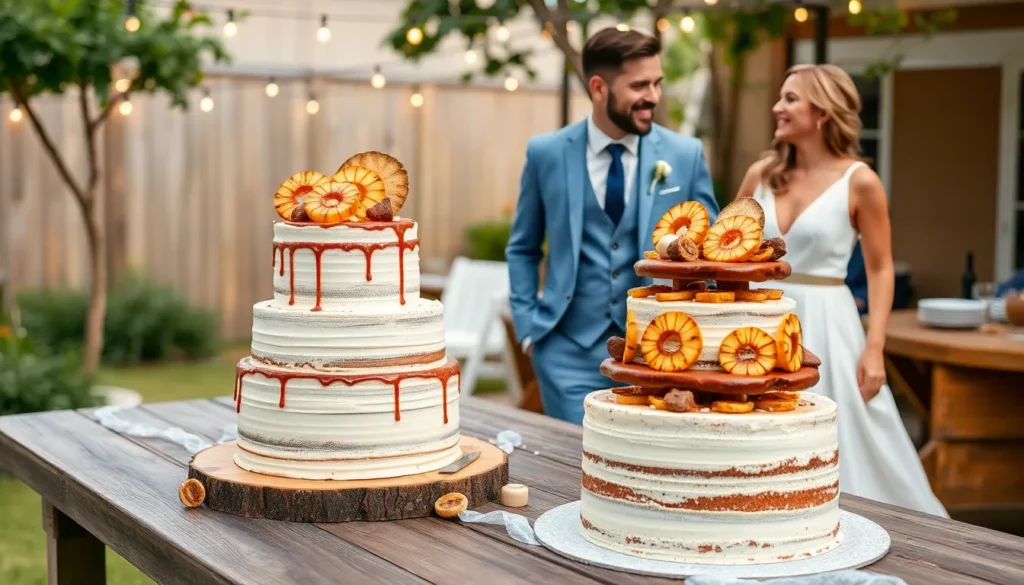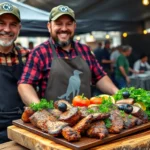Planning the perfect “I Do” BBQ celebration calls for a cake that’s as smoky and sweet as your love story. We’ve discovered that combining wedding elegance with backyard BBQ charm creates unforgettable moments that guests will talk about for years.
BBQ-themed wedding cakes aren’t just desserts – they’re conversation starters that reflect your personality as a couple. From rustic naked cakes adorned with miniature grills to sophisticated tiered designs featuring edible BBQ elements, we’ll show you how to create the centerpiece that perfectly captures your laid-back wedding vibe.
Grilled Pineapple Upside-Down Cake
Transform your BBQ wedding celebration with this show-stopping dessert that perfectly marries traditional baking with outdoor grilling expertise.
Sweet and Smoky Flavor Profile
Caramelized pineapple rings create the foundation of this incredible BBQ cake, developing deep amber flavors when exposed to direct grill heat. We recommend using fresh pineapple slices rather than canned varieties to achieve optimal caramelization and natural sweetness. Brown sugar melts into rich butterscotch notes while the grill’s smokiness infuses subtle barbecue undertones throughout the entire cake.
Vanilla cake batter absorbs these complex flavors during the grilling process, creating layers of taste that remind guests of summer evenings and backyard gatherings. Cherry garnishes add pops of color and tartness that balance the dessert’s inherent sweetness. Butter transforms into nutty, toasted notes when it hits the hot grill grates, elevating this classic dessert into something truly memorable for your wedding day.
Essential Grilling Techniques
Cast iron skillets work best for grilling upside down cakes because they distribute heat evenly and can withstand high temperatures without warping. We suggest preheating your grill to medium heat (around 350°F) and creating zones with direct and indirect cooking areas. Place the skillet over indirect heat to prevent the bottom from burning while ensuring the cake cooks through completely.
Cover the grill with its lid to create an oven-like environment that promotes even baking throughout the cake’s interior. Check the cake’s doneness by inserting a toothpick into the center after 25-30 minutes of cooking time. Rotate the skillet halfway through cooking to compensate for any hot spots your grill might have.
Remove the cake from heat and let it cool for exactly 5 minutes before flipping it onto your serving plate. This timing ensures the pineapple topping stays intact while preventing the cake from sticking to the pan.
BBQ Chocolate Lava Cake

We’re taking our BBQ wedding desserts to the next level with this show-stopping chocolate lava cake that delivers molten perfection straight from your grill. This impressive dessert combines the outdoor charm of BBQ cooking with the elegance of a restaurant-quality dessert.
Cast Iron Cooking Method
Prepare your 12″ cast iron skillet or Dutch oven by greasing it thoroughly with butter or shortening to prevent any sticking during the grilling process. Cast iron provides exceptional heat retention and even distribution that’s perfect for creating the ideal lava cake texture.
Create the batter by mixing flour, sugar, and cocoa powder with milk and vanilla until you achieve a smooth consistency. Melt butter directly in your cast iron skillet first, then carefully spoon the prepared batter over the melted butter base.
Build the lava topping by combining sugar and cocoa powder, then sprinkling this mixture generously over your batter. Slowly pour boiling water or hot coffee over the cocoa sugar topping to create that signature molten lava effect as the cake bakes.
Position the cast iron directly on your grill grates for indirect cooking, ensuring even heat circulation around the dessert. Dutch oven users should place charcoal briquettes both underneath and on top of the lid to create consistent surrounding heat for uniform baking.
Temperature Control Tips
Stabilize your grill temperature at 350°F (175°C) to ensure even baking without burning the delicate chocolate cake. Consistent temperature control is crucial for achieving that perfect balance between a set exterior and gooey interior.
Set up indirect heat by placing coals or heat bricks on either side of your grill rather than directly under the cast iron skillet. This setup prevents excessive direct heat that could burn the bottom of your cake before the top properly sets.
Close the grill lid immediately after placing your cast iron on the grates to maintain consistent heat and allow the cookware to gradually reach optimal cooking temperature. The enclosed environment mimics an oven while adding subtle smoky flavors.
Bake for 30 minutes in a cast iron skillet or extend to 55 minutes for Dutch oven preparation until the top sets completely while the center remains deliciously gooey. Monitor the cake’s progress without opening the lid frequently to maintain stable temperatures.
Rest the finished cake for 10 minutes after removing from heat to allow the molten center to thicken slightly before serving with vanilla ice cream or fresh whipped cream.
Smoked Carrot Cake With Cream Cheese Frosting

Transform your BBQ wedding dessert with this innovative smoked carrot cake that brings together outdoor cooking techniques and classic comfort food flavors. We’ll show you how smoking adds a subtle depth to traditional carrot cake while maintaining the moist, tender crumb your guests expect.
Wood Chip Selection Guide
Mild fruit woods deliver the best results when smoking carrot cake since they complement rather than overpower the delicate spice flavors. Apple wood chips create a gentle sweetness that enhances the cinnamon and nutmeg in your cake batter. Cherry wood provides a slightly richer smoke profile that pairs beautifully with the natural sweetness of grated carrots.
Pecan wood offers another excellent option for those seeking a nutty undertone that matches perfectly with walnuts or pecans in the cake recipe. Strong woods like mesquite or hickory should be avoided entirely as they can create bitter, overpowering flavors that mask the cake’s natural taste. Soaking your chosen wood chips in water for 30 minutes before smoking ensures a steadier, gentler smoke production throughout the cooking process.
Moisture Retention Secrets
Oil based recipes work exceptionally well for smoked cakes since they maintain moisture better than butter based alternatives during the low and slow cooking process. Adding buttermilk or sour cream to your carrot cake batter creates extra tenderness and helps combat the drying effects of prolonged smoking. Wrapping your cake pan in foil during the first half of smoking creates a steam effect that keeps the cake moist.
Placing a water pan directly in your smoker maintains optimal humidity levels throughout the cooking process. We recommend maintaining smoker temperatures between 225°F and 275°F to ensure even cooking without excessive moisture loss. Cooling the finished cake in its pan for 10 minutes before removing prevents rapid moisture evaporation that can leave your cake dry.
Properly stored smoked carrot cake with cream cheese frosting maintains its moisture for up to one week when refrigerated in an airtight container.
Grilled Pound Cake With Berry Compote
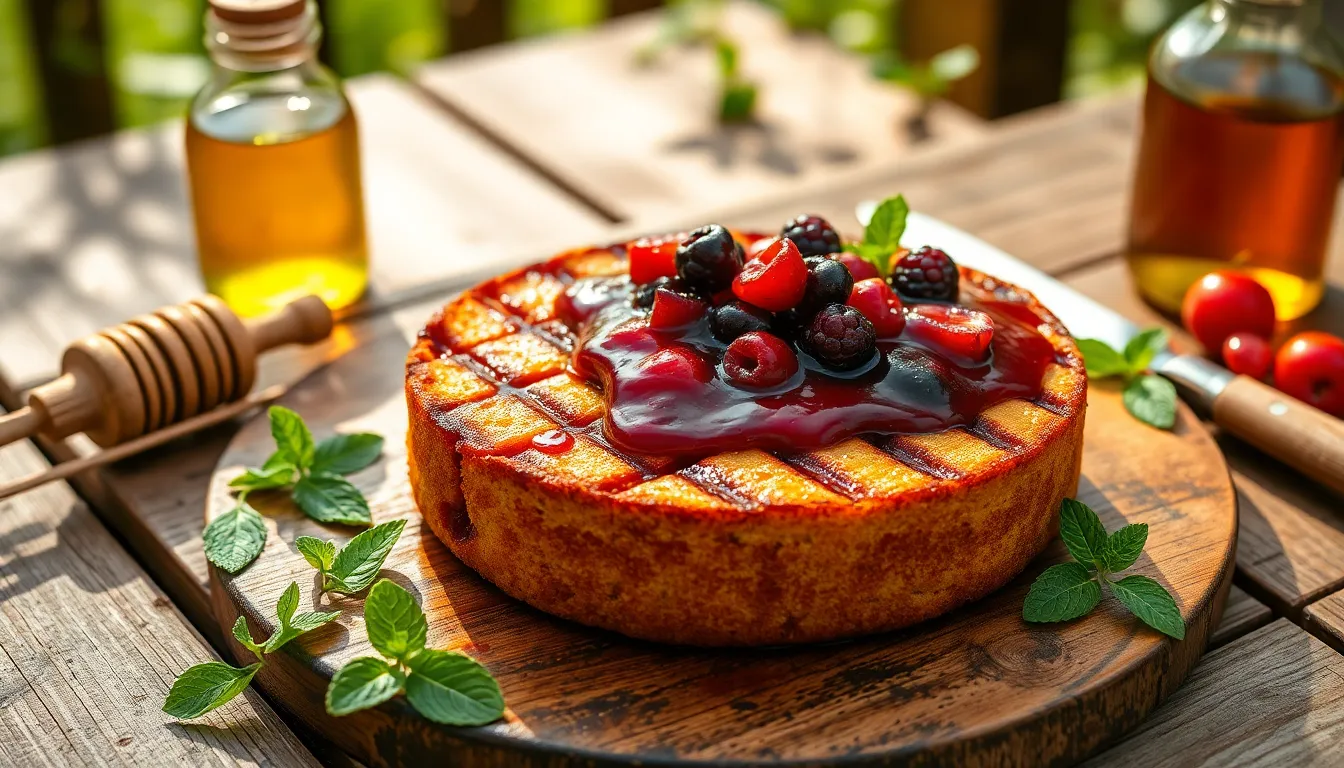
We’re taking dessert outdoors with this elevated grilled pound cake that transforms a classic comfort food into a BBQ masterpiece. Grilling adds a smoky depth while creating beautiful caramelized edges that perfectly complement sweet berry toppings.
Direct vs Indirect Heat Methods
Direct heat grilling places pound cake slices right on the grill grates for maximum char and distinct grill marks. We recommend using medium-high heat settings that deliver the perfect crispy exterior in just 4-5 minutes per side. Brush each slice with melted butter before grilling to enhance browning and add rich flavor. Consider using a grill pan if your outdoor grill has wide openings to prevent cake pieces from falling through.
Indirect heat cooking offers more control for even results without aggressive charring. Position cake slices away from direct flames or use your grill’s rotisserie feature for consistent heat distribution. This gentler method prevents burning while ensuring uniform texture throughout each slice. We find this technique particularly useful when grilling thicker pound cake portions that need more time to warm through.
Topping Combinations
Berry compote combines fresh strawberries, blueberries, and raspberries with sugar and lemon juice for the ultimate classic pairing. Cook these ingredients together until the berries break down and create a syrupy consistency that clings beautifully to warm cake. Prepare this topping in advance to allow flavors to meld and intensify.
Sweetened whipped cream provides a cooling contrast to the warm grilled cake with its light, airy texture. Mix confectioners’ sugar and vanilla extract into heavy cream for a dollop that balances the smoky cake flavors. This creamy addition works especially well when the cake is still warm from the grill.
Fresh fruit options like sliced strawberries or whole blueberries offer a lighter alternative for those preferring uncooked toppings. These raw fruits maintain their natural brightness and provide textural variety against the grilled cake’s caramelized surface.
Mint and honey combinations bring freshness and natural sweetness to each bite. Garnish with fresh mint sprigs and drizzle honey over the entire dessert for an elegant finishing touch that enhances the outdoor dining experience.
BBQ Banana Foster Cake

BBQ Banana Foster Cake brings the classic New Orleans dessert to your outdoor grilling space with rich caramelized flavors and smoky undertones. We’ll transform traditional bananas foster into a grilled masterpiece by combining pound cake slices with a caramelized banana topping made from butter, brown sugar, cinnamon, banana slices, and rum.
Caramelization Process on the Grill
Caramelization creates the signature rich flavor and golden color that makes this BBQ dessert extraordinary. We achieve this by grilling pound cake slices directly over moderate heat, allowing the natural sugars to brown and develop complex flavors. Sugar in both the cake and banana topping interacts with the grill’s dry heat to form a slightly crisp, flavorful crust.
Moderate indirect heat works best for proper caramelization without burning the delicate cake layers. We recommend setting your grill to medium heat and positioning the cake away from direct flames. Natural sugars in the banana slices caramelize beautifully when grilled, creating enhanced sweetness and improved texture.
Temperature control prevents charring while maximizing flavor development during the caramelization process. We suggest maintaining consistent heat levels and monitoring the cake closely as sugars can quickly transition from golden to burnt. Flambéing with rum on the grill adds dramatic caramelization effects, though this technique requires extra caution to prevent dangerous flare ups.
Safety Precautions for Open Flame Cooking
Fire safety becomes critical when preparing BBQ Banana Foster Cake, especially during the flambéing process with rum. We always keep a fire extinguisher or baking soda within easy reach to handle potential alcohol flame flare ups quickly. Long handled utensils maintain safe distance from open flames while allowing proper control over the cooking process.
Loose clothing poses serious risks around open flames, so we recommend wearing fitted garments and tying back long hair. Clear workspace preparation involves removing all flammable materials from the grilling area before beginning the flambéing process. Stable grill setup on flat surfaces prevents dangerous tipping that could spread flames or cause injuries.
Constant supervision remains essential throughout the entire open flame cooking process, particularly when alcohol is involved. We never leave flames unattended during any stage of preparation, from grilling the pound cake to flambéing the banana topping. Proper ventilation helps prevent alcohol vapor buildup that could create unexpected ignition sources during the cooking process.
Smoky S’mores Cheesecake
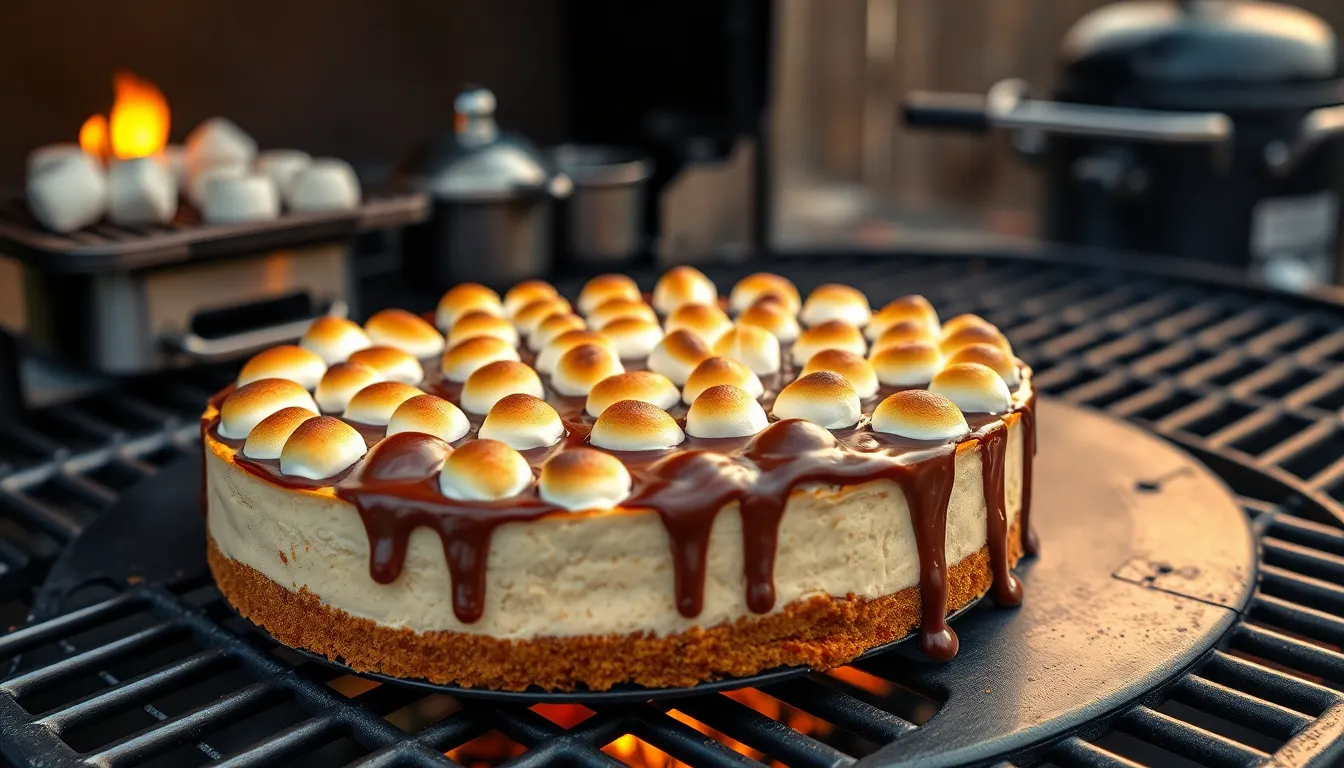
We’re taking the beloved campfire treat to new heights with this grilled cheesecake that combines creamy texture with outdoor smoky flavors. This dessert transforms your BBQ wedding celebration into a sophisticated yet nostalgic experience that’ll have guests talking long after the last bite.
No-Bake Grilling Techniques
Preparation of this no-bake version starts with creating a stable cheesecake base using gelatin or stabilizers that’ll set without traditional baking. We combine cream cheese with sugar, vanilla, and heavy cream, then add unflavored gelatin to ensure the filling holds its shape during the grilling process.
Assembly involves layering the prepared filling over our graham cracker crust, then chilling the cheesecake for at least 4 hours before moving to the grill. We top the set cheesecake with mini marshmallows, broken chocolate bars, and graham cracker pieces just before grilling.
Grilling uses indirect heat with the grill lid closed to create an oven effect that toasts the marshmallows and melts the chocolate without overcooking the filling. We place the cheesecake on the cooler side of the grill, maintaining temperatures around 300°F for 15 to 20 minutes until the toppings achieve that perfect golden brown color.
Monitoring throughout the process ensures we achieve the ideal balance of toasted toppings while keeping the creamy base intact. We use grill vents to control airflow and prevent excessive heat from compromising the cheesecake’s texture.
Graham Cracker Crust Preparation
Foundation building starts with 1½ cups of finely crushed graham crackers, which we process until they reach a consistent crumb texture. We combine these crumbs with ⅓ cup melted butter, ¼ cup brown sugar, and a pinch of salt for enhanced flavor depth.
Mixing requires thorough incorporation of all ingredients until the mixture holds together when pressed between our fingers. We add an extra tablespoon of melted butter if the mixture appears too dry or crumbly.
Pressing the mixture into a 9-inch springform pan creates an even base that extends slightly up the sides for structural support. We use the bottom of a measuring cup to firmly compact the crust, ensuring it won’t crumble when we slice the finished cheesecake.
Pre-smoking adds an extra layer of flavor by placing the formed crust in our smoker or on the grill for 10 minutes at 275°F before adding the filling. This technique infuses the crust with subtle smoky notes that complement the s’mores flavor profile without overwhelming the dessert’s delicate balance.
Grilled Peach Cobbler Cake
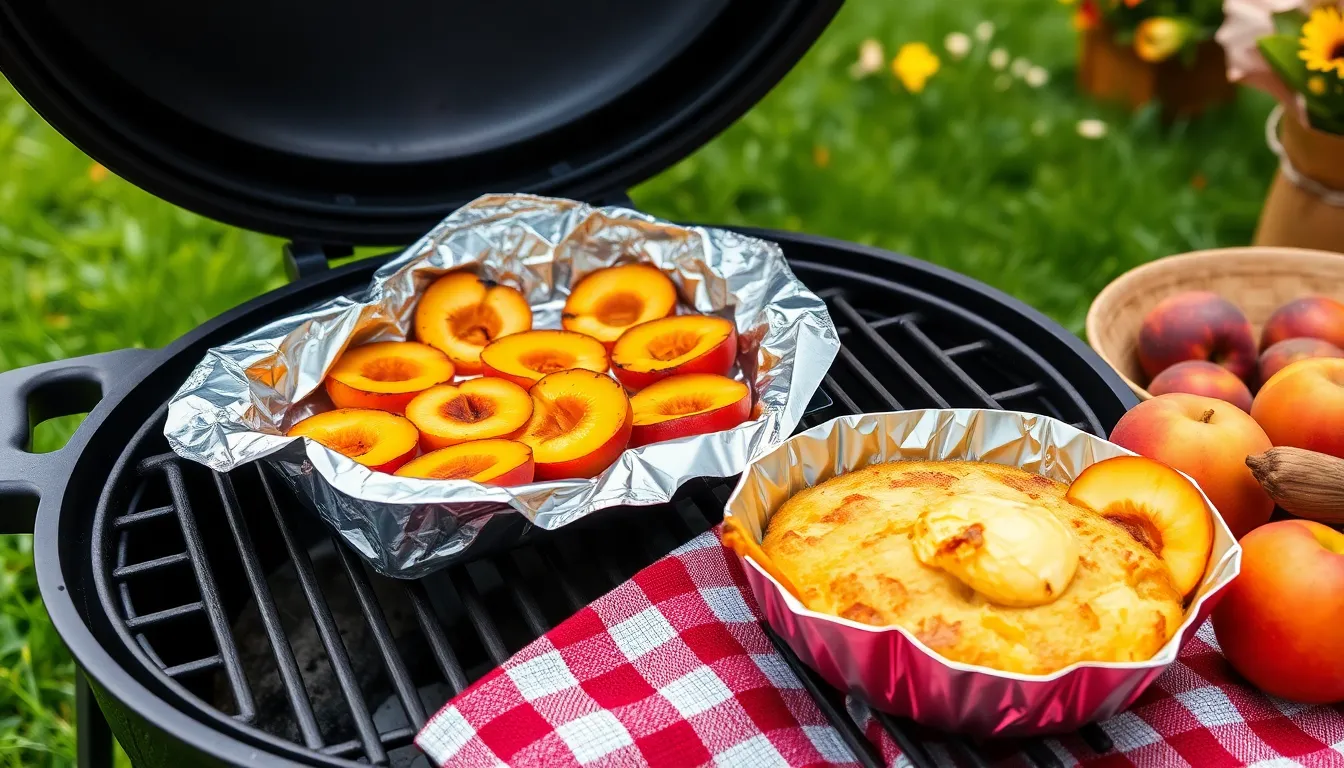
We’ll explore the ultimate BBQ dessert that transforms traditional peach cobbler into a grilled masterpiece perfect for outdoor celebrations.
Seasonal Fruit Selection
Fresh peaches deliver the best flavor when they’re in season from late spring through early fall. We recommend selecting peaches that yield slightly to gentle pressure and have a sweet aroma at the stem end. Freestone varieties work exceptionally well for grilling since the flesh separates easily from the pit.
Canned peaches offer year-round convenience and consistent results for your grilled cobbler. They’re already sweetened and maintain their texture during the grilling process. We suggest using peaches packed in heavy syrup for richer flavor or juice-packed varieties for a lighter option.
Complementary fruits enhance the cobbler experience when mixed with peaches. Nectarines provide similar sweetness with a firmer texture, while fresh berries like blueberries or blackberries add tartness and color contrast. Stone fruits like plums create depth with their wine-like flavors when caramelized over the grill.
Grilled preparation intensifies natural sugars in fresh peaches through caramelization. We halve and pit the peaches, then grill them cut-side down for approximately 4 minutes until char marks appear. This technique concentrates flavors and creates smoky undertones that elevate the traditional cobbler taste.
Foil Packet Cooking Method
Individual foil packets create personalized servings that cook evenly and make cleanup effortless. We layer sliced peaches, cake mix, and butter pats in heavy-duty aluminum foil, then seal the edges tightly to trap steam. This method works particularly well when cast iron skillets aren’t available.
Steam cooking preserves fruit juices while allowing the cake topping to develop properly. The foil creates a mini-oven effect that locks in moisture and prevents the fruit from drying out. We recommend double-wrapping packets to prevent tears and juice leakage during grilling.
Temperature control becomes easier with foil packet cooking since the enclosed environment maintains consistent heat. We place packets on the cooler side of the grill for indirect cooking at approximately 375°F. This prevents burning while ensuring thorough cooking throughout.
Cooking time ranges from 25 to 35 minutes depending on packet size and fruit quantity. We test doneness by carefully opening one packet and checking that the topping is golden brown and the fruit bubbles actively. The cake mix should appear set rather than doughy when properly cooked.
BBQ Red Velvet Bundt Cake
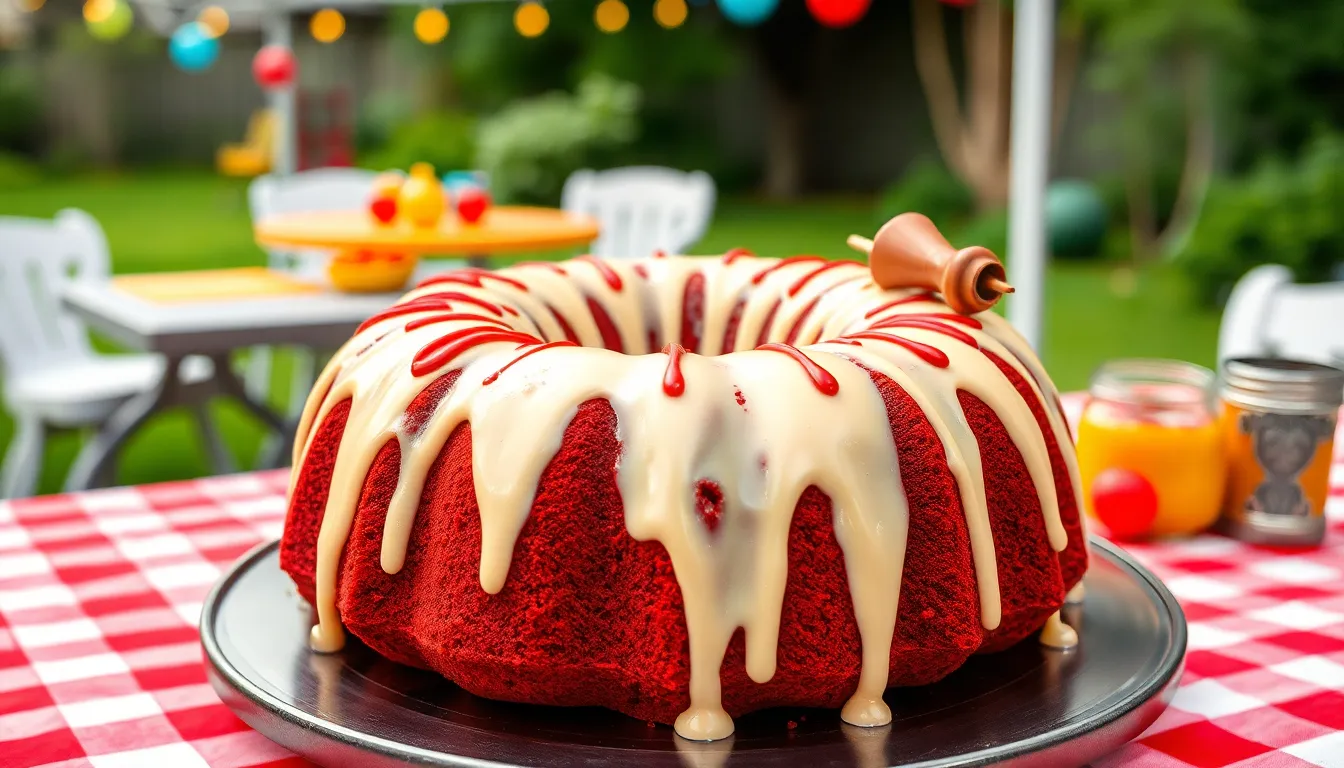
Our BBQ Red Velvet Bundt Cake combines the classic moist, subtly chocolate-flavored red velvet with the elegant ring shape that’s perfect for outdoor celebrations. This sophisticated dessert brings restaurant-quality presentation to your backyard BBQ while offering the practical benefits of even cooking.
Achieving Even Heat Distribution
Even heat distribution becomes crucial when we’re working with dense red velvet batter in outdoor cooking conditions. The Bundt pan’s central tube allows heat to reach the middle of our cake more efficiently, ensuring the interior cooks fully without burning the edges.
We recommend positioning your cake on the center rack of your grill or oven for balanced airflow around the entire pan. Temperature control requires maintaining a moderate 325-350°F throughout the baking process to allow gentle, even cooking of the dense batter.
Preheating creates stable heat conditions before our cake enters the cooking environment. Oven calibration using a reliable thermometer confirms accurate temperatures, especially important for outdoor grilling setups where heat can fluctuate.
Space around the pan promotes proper heat circulation, so we avoid overcrowding the cooking area. These techniques prevent the common problems of undercooked centers or overly browned exteriors that can ruin even the most carefully prepared red velvet cake.
Glaze Application Techniques
Glazing transforms our BBQ Red Velvet Bundt Cake into a visually stunning centerpiece that enhances both flavor and presentation. We allow the cake to cool completely before applying any glaze to prevent melting and ensure proper adhesion.
Cream cheese glaze works exceptionally well with red velvet’s subtle chocolate notes, while light chocolate ganache creates an elegant finishing touch. Controlled application using a spoon or piping bag ensures even coverage across the cake’s decorative ridges.
Pouring technique involves slow, steady movements while rotating the cake to achieve a smooth, professional finish. We let the glaze set at room temperature, or chill briefly for a firmer consistency that holds its shape better in outdoor conditions.
Decorative touches can include edible paint or colored buttercream to mimic grill marks or BBQ sauce drips, adding playful visual elements that tie into your BBQ theme. These finishing techniques create conversation starters that reflect the creativity of combining elegant baking with outdoor celebration themes.
Smoked Lemon Drizzle Cake

We’re taking the classic British lemon drizzle cake to new heights by incorporating BBQ smoking techniques. This transformation creates a dessert that balances traditional citrus brightness with subtle smoky complexity.
Citrus Enhancement Through Smoking
Smoking citrus elements before incorporating them into our cake batter dramatically elevates the flavor profile. We recommend smoking fresh lemons at 200°C for 15-20 minutes before zesting and juicing them, which adds mild smoke notes alongside their natural tartness. This technique creates a more complex aroma that complements the bright acidity without overpowering the cake’s delicate texture.
Quality ceramic grills or dedicated smokers work best for maintaining the controlled moderate temperatures needed for this process. We’ve found that indirect heat allows the cake to develop a tender crumb while infusing those desirable smoky citrus nuances throughout. The combination of citrus zest in the batter plus the lemon-sugar drizzle creates layered flavors that balance sweet, tart, and smoky elements perfectly.
Temperature control remains crucial for success. We maintain our smoker around 175-200°C and cook for approximately 45 minutes until the internal temperature reaches 95°C. Using rapeseed oil instead of butter can improve moisture retention during the smoking process, and we always poke the warm cake with a skewer before applying the lemon syrup drizzle.
Presentation and Garnish Ideas
Fresh lemon zest curls make stunning garnishes that we lightly smoke or grill for intensified aroma and visual appeal. Thin lemon slices can receive the same treatment, creating beautiful citrus wheels that echo the cake’s smoky theme. We dust the finished cake with powdered sugar or brush it with additional lemon glaze for that glossy, professional finish.
Contrasting textures elevate the entire dessert experience. We serve alongside vanilla ice cream or freshly whipped cream to offset the smoky sharpness, while fresh herbs like mint or thyme add complementary flavors plus vibrant green accents. Edible flowers and candied lemon peel provide elegant touches that transform this BBQ creation into something special.
Rustic presentation amplifies the outdoor cooking theme. We plate on wooden boards or slate surfaces that emphasize the BBQ connection, making this dessert feel perfectly at home in your outdoor celebration. These thoughtful garnishing techniques create both visual impact and enhanced taste appeal for a truly unique BBQ wedding cake experience.
Fire-Roasted Apple Cinnamon Cake
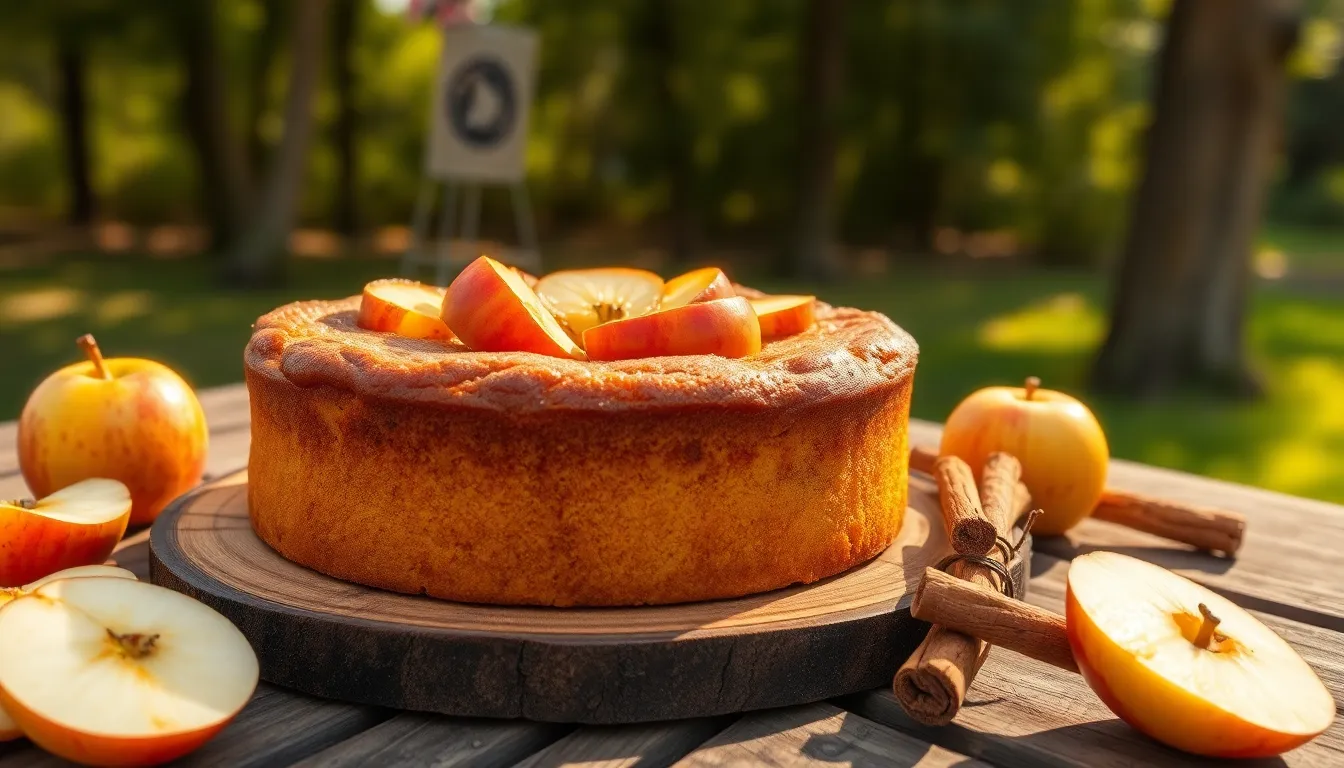
We’ll create an exceptional BBQ dessert that combines rustic outdoor cooking with classic comfort flavors through our fire-roasted apple cinnamon cake.
Wood-Fired Flavor Infusion
Wood-fired cooking transforms our apple cinnamon cake into something extraordinary by infusing subtle smoky notes throughout the batter. Setting up our BBQ for indirect cooking at 150-170°C creates an oven-like environment while allowing wood smoke to enhance the cake’s flavor profile. The process begins by removing the center grill and installing a heat diffuser with baking rack to ensure even heat distribution.
During the baking process, wood smoke naturally permeates the cake batter, creating a deeper complex aroma that combines sweetness and spiced elements with rustic smoky undertones. Our cake develops an enhanced crust texture due to the radiant heat and smoke exposure, resulting in a unique flavor profile that elevates ingredients like fresh apples and warm cinnamon beyond traditional oven baking.
The preparation involves creaming butter and sugar, then incorporating egg, maple syrup, and vanilla extract before folding in flour and milk. We layer peeled, cored apple slices on top of the batter in our lined 20cm round cake tin, then sprinkle brown sugar, cinnamon, and butter pieces over the apples for maximum flavor development.
Serving Temperature Recommendations
Our fire-roasted apple cinnamon cake reaches peak flavor when served warm, highlighting the melting butter and softened apple textures. We recommend removing the cake from the BBQ once baked and allowing it to cool for 10-15 minutes to set properly before slicing.
Serving the cake slightly warm enhances the release of aromatic cinnamon and wood smoke flavors, creating an optimal tasting experience. The warm temperature also preserves the cake’s moist texture while allowing the caramelized apple topping to maintain its appealing consistency.
For make-ahead preparation, we suggest gently reheating the cake before serving to restore the ideal texture and flavor balance. This approach ensures our guests experience the full depth of the wood-fired flavors and the comforting warmth that makes this BBQ dessert truly memorable.
Conclusion
These BBQ cake ideas prove that outdoor wedding celebrations don’t require compromising on dessert elegance. We’ve shown you how to transform traditional favorites into smoky masterpieces that’ll have your guests talking long after the last bite.
The beauty of BBQ wedding cakes lies in their versatility. Whether you’re drawn to the sophisticated charm of a smoked lemon drizzle cake or the rustic appeal of fire-roasted apple cinnamon each option brings unique flavors that complement your outdoor celebration perfectly.
Remember that successful BBQ baking is all about temperature control and timing. With the right techniques and a bit of practice you’ll create desserts that capture both the romance of your special day and the laid-back spirit of outdoor entertaining.
Your BBQ wedding cake should reflect your personality as a couple. Choose flavors that speak to you and don’t be afraid to experiment with different smoking woods and grilling techniques to make your dessert truly unforgettable.
Frequently Asked Questions
What makes a BBQ-themed wedding cake different from traditional wedding cakes?
BBQ-themed wedding cakes combine elegance with rustic charm, featuring outdoor cooking techniques like grilling or smoking. They serve as conversation starters that reflect the couple’s personality while maintaining the celebratory nature of a wedding dessert. These cakes often incorporate smoky flavors, caramelized elements, and creative presentations that complement the relaxed outdoor atmosphere.
Can you actually grill a wedding cake successfully?
Yes, you can successfully grill wedding cakes using proper techniques. Use cast iron skillets or Dutch ovens for even heat distribution, maintain stable temperatures around 350°F (175°C), and employ indirect heat methods. Key factors include timing, temperature control, and choosing appropriate cake recipes that work well with outdoor cooking methods.
What’s the best wood for smoking wedding cakes?
Mild fruit woods like apple and cherry are ideal for smoking wedding cakes. These woods provide complementary sweet flavors without overpowering the dessert. Avoid stronger woods like hickory or mesquite, as they can create harsh flavors that clash with the cake’s sweetness and delicate texture.
How do you keep grilled cakes moist during outdoor cooking?
Use oil-based recipes instead of butter-based ones, add buttermilk or sour cream for extra moisture, and wrap cake pans in foil during cooking. Maintain smoker temperatures between 225°F-275°F, cool cakes in their pans, and store properly in airtight containers. These techniques help retain moisture throughout the cooking and storage process.
What are some popular BBQ wedding cake flavors?
Popular options include Grilled Pineapple Upside-Down Cake, BBQ Chocolate Lava Cake, Smoked Carrot Cake, Grilled Pound Cake with Berry Compote, BBQ Banana Foster Cake, Smoky S’mores Cheesecake, Grilled Peach Cobbler Cake, BBQ Red Velvet Bundt Cake, Smoked Lemon Drizzle Cake, and Fire-Roasted Apple Cinnamon Cake.
How far in advance can you make BBQ wedding cakes?
Most BBQ wedding cakes can be made 1-3 days in advance when properly stored. Smoked carrot cake stays moist for up to a week when refrigerated in an airtight container. For best results, prepare components separately and assemble closer to serving time, especially for cakes with fresh toppings or delicate frostings.
What equipment do you need for BBQ wedding cake baking?
Essential equipment includes cast iron skillets or Dutch ovens, foil for wrapping, a reliable grill thermometer, Bundt pans for even heat distribution, and wood chips for smoking. You’ll also need proper ventilation for safety, especially when using alcohol-based recipes that require flambéing during the cooking process.
Are BBQ wedding cakes safe to make at outdoor venues?
Yes, with proper safety precautions. Maintain constant supervision during cooking, ensure adequate ventilation for smoking and flambéing, use stable cooking surfaces, and have fire safety equipment nearby. Follow temperature guidelines carefully and allow proper cooling time before serving to ensure both safety and optimal taste.

